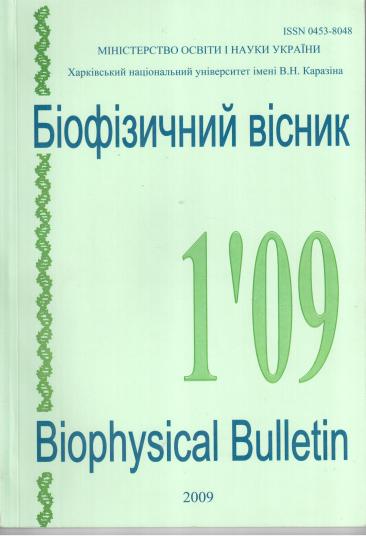Intrinsic fluorescence of lysozyme in model protein-lipid systems
Abstract
Fluorescence spectroscopy is one of the most powerful tools providing new insights into the structural, dynamic, and functional behavior of biological macromolecules, being particularly useful in investigating the molecular details of the protein-lipid association. Complete and accurate information about the conformational dynamics of protein molecules can be obtained using tryptophan (Trp) residues as intrinsic fluorescence probes. The fluorescence of indole chromophore is extremely sensitive to the environment making it an ideal choice for reporting protein conformational transitions upon membrane interactions. Hen egg-white lysozyme (Lz) is a multi-tryptophan protein that is extensively used in elucidating fundamental aspects of protein-lipid interactions. The main emitters responsible for 80% of lysozyme fluorescence are Trp62 and Trp108. The present study was undertaken to ascertain the alterations in lysozyme structural state upon association with model membranes composed of zwitterionic lipid 1-stearoyl-2-oleoyl-sn-glycerol-3-phosphocholine (SOPC) and anionic lipid 1-palmitoyl-2-oleoyl-sn-glycerol-3-phosphoglycerol (POPG). Fluorescence lifetime measurements showed that intensity-averaged lifetime (<τ>) of Trp residues in lysozyme decreased upon the protein binding to model membranes. Furthermore, <τ> reduction from 1.94 to 1.74 ns was observed at decreasing lipid-to-protein molar ratio (L:P) from 1130 to 120. It was suggested that Trp specific interactions with certain amino acid residues in its surroundings are the main factor responsible for the recovered decrease in tryptophan lifetime and the observed contradictions between lifetime, quenching, and steady-state experiments. Since Lz is a stable protein whose conformation is reported to change insignificantly upon the formation of protein-lipid contacts, it can be assumed that the processes behind the drop in <τ> involve Lz self-association in a membrane-bound state. Trp62 and Trp108 are located in the protein active site which reportedly participates in Lz aggregation. Moreover, the Cys76-Cys94 disulfide bridge capable of efficient quenching of Trp fluorescence and reducing the lifetime of protein fluorophores also resides in the active site cleft. Thus, it may be supposed that interactions between Trp62 and Trp108 of one Lz monomeric molecule with disulfide bridge of another monomeric molecule during the protein aggregation result in the reduction of <τ> values. The <τ> dependence on L:P can be explained by the fact that lysozyme self-association is apparently a coverage-dependent process controlled by both electrostatic and hydrophobic protein-lipid interactions. Additional arguments in favor of the assumption on Lz aggregation come from the time-resolved anisotropy measurements. Lysozyme rotational correlation time which reflects the motion of the whole protein molecule was found to exhibit a twofold increase at increasing L:P values. The recovered membrane's ability to modulate Lz aggregation behavior may largely determine the bactericidal and amyloidogenic propensities of this protein.
Downloads
References
Lakowicz J. Principles of fluorescent spectroscopy, Plenum Press: NY, 1999, 698 p.
Gorbenko G.P. et al. The role of lipid–protein interactions in amyloid-type protein
fibril formation // Chem. Phys. Lipids. – 2006. – V. 141. – P. 72-82.
Engelborghs Y. Correlating protein structure and protein fluorescence // J. Fluoresc.
– 2003. – V. 13. – P. 9-15.
Mui B. et al. Extrusion technique to generate liposomes of defined size // Meth.
Enzymol. – 2003. – V. 367. – P. 3-14.
Imoto T. et al. Fluorescence of lysozyme: emission from Trp residues 62 and 108
and energy migration // Proc. Natl. Acad. Sci. USA. – 1971. –V. 69. – P. 1151-1155.
Sankaram M. et al. Protein-lipid interactions with peripheral membrane proteins // In
Protein-lipid interactions, Elsevier. – 1993. – P. 127-162.
Banerjee S.K. et al. Self-association of lysozyme. Thermochemical measurements:
effect of chemical modification of Trp62, 108 and Glu35 // J. Biol. Chem. – 1975. –
V. 250. – P. 8260-8266.
E. Nishimoto et al. Internal motions of lysozyme studies by time-resolved
fluorescence depolarization of tryptophan residues // Biochemistry. – 1998. –V. 37. –
P. 5599-5607
Authors who publish with this journal agree to the following terms:
- Authors retain copyright and grant the journal right of first publication with the work simultaneously licensed under a Creative Commons Attribution License that allows others to share the work with an acknowledgement of the work's authorship and initial publication in this journal.
- Authors are able to enter into separate, additional contractual arrangements for the non-exclusive distribution of the journal's published version of the work (e.g., post it to an institutional repository or publish it in a book), with an acknowledgement of its initial publication in this journal.
- Authors are permitted and encouraged to post their work online (e.g., in institutional repositories or on their website) prior to and during the submission process, as it can lead to productive exchanges, as well as earlier and greater citation of published work (See The Effect of Open Access).





